Video Game Review: Resident Evil: The Umbrella Chronicles
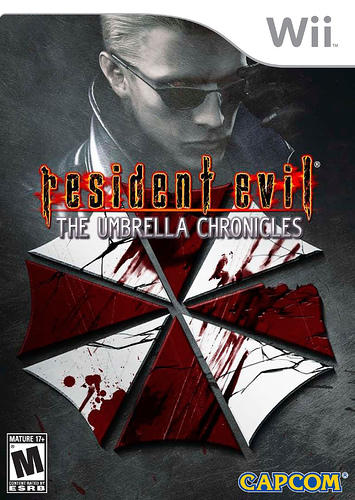 | | Resident Evil: The Umbrella Chronicles |
Resident Evil is Capcomís cash cow, a franchise that has spawned numerous games, a few so-bad-theyíre-good movies, novels, comic books, and even a thrill ride or two in Japan. The original game is considered the gold standard when it comes to the niche video game genre of survival horror, though it has come up against some stiff competition in the Silent Hill and Fatal Frame series.
I had never played a survival horror game until the lovingly-remastered version of the first Resident Evil made its way to the Nintendo Gamecube back in 2002, but I quickly became a fan. Though I havenít played every game in the franchise (a nearly impossible task) or even all of the ďcoreĒ games, I have played enough to consider myself a fan of Resident Evil.
After the staggeringly awesome Resident Evil 4 and all of its various ports, the wait for the next game in the series became painful like the way a heroin addict longs for his next injection. By all accounts, Resident Evil 5 is still about a year away, but an interesting addition to the brand made its way to the Nintendo Wii late last year. Though an on-rails shooter, Resident Evil: The Umbrella Chronicles is a worthy addition and a much-needed fix.
STORY
Up until Resident Evil 4, the story has been about viruses, zombies, biological weapons, giant mutated animals, and an omnipresent evil corporation unsubtly named Umbrella. Throughout the progression of the series to that point, it seemed as though the story was building to an ultimate confrontation between the survivors of the original game and Umbrella. However, just when that confrontation seemed inevitable, Resident Evil 4 decided to jump ahead in the timeline and unceremoniously explain in the opening cutscene that the Umbrella Corporation was no more.
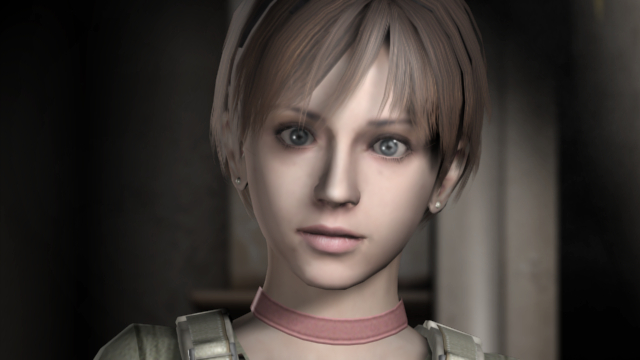 | | I don't know what it is, but there's just something about this zombie-filled mansion that seems strange... |
Resident Evil: The Umbrella Chronicles not only attempts to finally explain what happened to the evil company, but it also takes a quick jaunt through some of the earlier games: Resident Evil Zero, Resident Evil, and Resident Evil 3: Nemesis. Though this would be more than enough to keep a fanboy happy, there are also several extra levels detailing events happening on the fringes of the original stories.
For example, you get to find out how Rebecca Chambers made it to the mansion after the events of Resident Evil Zero, how Richard Aiken got bitten by that giant snake in Resident Evil, and most importantly, what ubervillain Albert Wesker was doing the whole time.
Though the final segment of the game seems to gloss over the details of how exactly Umbrella fell, many of the unlockable files, memos, and such do a good job of filling in the blanks. Also, while the franchiseís stories are not known for their artistic quality, I am happy to report that The Umbrella Chronicles covers the long-standing gap in the mythology with typical Resident Evil flare (and a few nods to the extended universe, such as the addition of the film's Red Queen supercomputer). There are no jaw-dropping twists, but the story is deeper than you might expect from an on-rails shooter.
GAMEPLAY
Still, the on-rails shooter mechanic is not what one thinks of when one thinks Resident Evil. Though The Umbrella Chronicles is not the first shooter in the franchise, it is a big departure from the methodically tense survival horror.
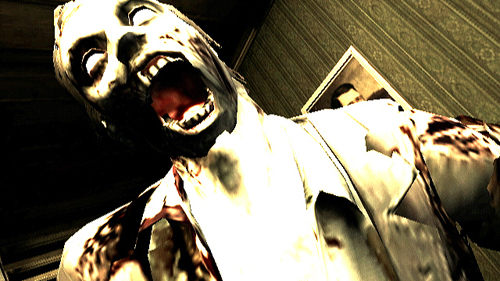 | | Hey, Baby, it's not just your hot body; I'm also interested in your brains! |
So donít expect a game that wigs you out with long walks down dark uneventful alleyways, waiting for the short bursts of zombie violence. From the very start of the game, you will see zombies and mutants on the screen, and there are only a handful of very brief pauses in the action. (The very beginning contains some frustratingly unnecessary tutorial intrusions, but after you've seen them once, they never return.) There are no complicated puzzles involving square-pegged hand cranks or bronze medallions; instead, there are only things to shoot at.
And there are lots of things to shoot at, not just monsters. The environments have many destructable objects, such as lights, pictures, pots, crates, cars, and the obligatory exploding barrels. Destroying them grants you access to ammo, health, and unlockables.
Ammo is critical for your power weapons, but you maintain an infinite supply for your handgun, which helps boost the shooter aspects of the game while downplaying the survival horror. This is a good thing, because it shows that the designers of the game were true to the type of game they were making. They did a fantastic job of merging an on-rails shooter with the Resident Evil feel, but at no point did they compromise their intent.
There are a handful of secret rooms to be found by blasting doors open and a few places where you are given the choice to take an alternate route, but you are pretty restricted by the path the game lays out for you. Again, this takes away the exploration and light adventure aspects of the core games in the franchise, but having such aspects in an on-rails shooter would make no sense.
There are times (one boss battle especially comes to mind) when the camera is so quick that it becomes frustratingly difficult to aim your weapon, but for the most part, the movements are fluid and steady enough to prevent such problems. Still, you move fast through the environments, and if you miss your chance to grab that unlockable in the corner, you probably arenít going to be able to get it again unless you start the level over. Luckily, once they appear on screen, they are bright, flashy, and so out-of-place that you canít overlook them.
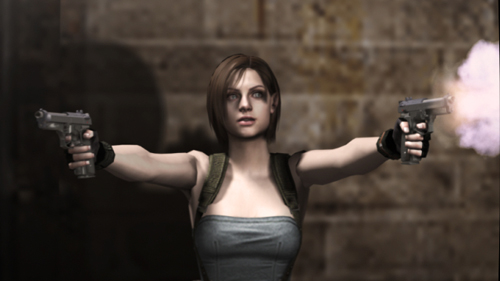 | | Don't get so distracted by what's holding her clothes on that you fail to notice Jill shooting you in the face |
There are some light RPG elements between chapters, where you use stars (earned based on your performance) to upgrade your various weapons. This is a nice touch, and makes going back to early levels more fun as you can obliterate the easier bosses in a matter of seconds with a fully upgraded Handcannon. It is also necessary to have good weaponry for the latter portion of the game, where the difficulty level becomes fairly extreme, but one unfortunate drawback is that your handgunóthough it has infinite ammoóis never upgraded in the game, making it virtually useless towards the end.
Despite a few reviews to the contrary, there are no problems to be found with the IR sensitivity and the Wii remote. Using the Wii Zapper is pretty satisfying, too. However, the action button-presses that come up during cutscenes and boss battles are made unnecessarily difficult by the oversight of not mapping the ďAĒ button to the ďZĒ button on the nunchuck. For every other usage, the ďZĒ button does the same as the ďA,Ē but during action sequences, where timing and reflexes are everything, being forced to hit the actual ďAĒ button within a fraction of a second is virtually impossible without arthritic contortions of your hand.
Otherwise, the controls are mapped well, and the feel of pulling the trigger and obliterating the face of a demon monkey is hard to match. Though hitting that sweet spot where a zombieís head pops off is pretty difficult, making that spot any bigger would make the game too easy.
And make no mistakes: this game is not easy. Even on its easiest setting, you will be hard-pressed to make it through the final chapters of the game before replaying many earlier chapters in order to upgrade your weapons, especially if youíre playing alone. Zombies wonít go down easy, infected beasts arenít going to hold still for you, and the boss battles are epic tests of mettle.
PRESENTATION
Iíve read reviews that complain about the graphics, and I have no idea what game those reviewers were playing. Though not as stylized as Resident Evil 4, The Umbrella Chronicles has impressive graphics that would stand up to those on the more intense consoles, as long as you donít go full HD. That means that the graphics are as good as the best on the Nintendo Wii so far, which is a welcome relief since many game designers on the Nintendo console seem to be unwilling to put any time into exploring the consoleís capabilities. While it could never compete with the graphical prowess of the XBox 360 or the PS3, the Wii is capable of much better than most games show, and The Umbrella Chronicles is one of the few games working the engine. There are a couple of frame rate issues in the game (crow feathers seem to be the culprit 99% of the time), but mostly, the movement stays fluid and never dips.
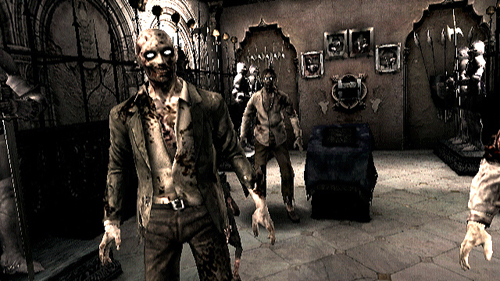 | | The good news is you don't have to move all those suits of armor around to open the panel and get the key to the next area--just blow it all up! |
The recreations of the previous games are lovingly well-done. The mansion and other locations from the first Resident Evil are especially notable in the care taken to accurately recreate every detail. The nitpicking fanboy might notice that some of the maps from Resident Evil 3 are taken from the Resident Evil: Outbreak series rather than the original source, but the slightly altered dimensions are a better fit for the on-rails shooter and are wholly appropriate as far as I can tell.
Iíve also read reviews that complain about the music in the game and, again, I donít agree. The music is pure Resident Evil, but slightly amped in tempo and mood to reflect the heavier action focus of the game. Personally, I donít think they could have done better.
Though it only supports one extra player, the multiplayer cooperative mode is excellent, and necessary if you want to burn through the storyline quickly. It is easier to fight with a buddy by your side, as the number or difficulty of the enemies is unaltered, but there are a few drawbacks. For instance, sometimes you lose track of which reticle is yours (if the game designers changed the appearance rather than just the color, this wouldnít be an issue), and you share a health bar. When one of you takes damage, you both feel the hurt. However, having twice the firepower and being able to stagger your reloads more than makes up for it. On the highest difficulty level, two players with good strategy can still have a fun time without it becoming a war of atrition the way it would in single-player mode.
Unfortunately, the bonus missions, which are the hardest chapters of the game, donít allow a friend to join in on the fun. While this makes sense from a story standpoint (you canít both be Wesker as he escapes the secret Umbrella facility beneath the mansion), itís a bit disappointing. Iíd gladly suspend my disbelief and allow two Weskers to fight side-by-side, but I guess you canít have everything. [NOTE: Eventually, you can unlock co-op mode for the single player missions and play as two Weskers, but you will probably have beaten the main game before this happens.]
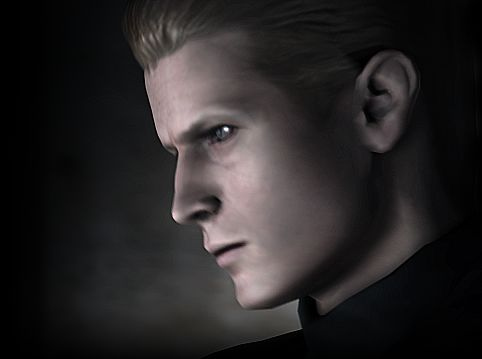 | | Wesker's a bad, bad man |
Still, these bonus missions up the replay value of the game. The game doesnít have much longevity after youíve beaten it, but perfecting your score, grabbing all the unlockables, and trying the higher difficulty settings are all good reasons to go back and play some more.
After all, itís a fun game to play in short spurts, and none of the chapters are long enough to give you that sense of dread upon starting it. So far, I havenít had a chapter last longer than twenty-five minutes, and even that was unusual. If you need to play for fifteen minutes just to unwind after work or school, itís easy to pop in the game, fill a few zombie bastards full of lead, get a reward, and then turn the game off. And if you want to waste away on your couch for hours on end doing the same thing, itís just as easy.
In other words, the game caters to you, which is what makes it fun despite its sudden scares and horrific (albeit campy) subject matter.
[Presentation: 54/60]
[Graphics & Sound: 10/10]
[Music: 10/10]
[Multiplayer: 7/10]
[Replay: 8/10]
[Extras: 9/10]
[Fun: 10/10]
|
|
FINAL TALLY
STORY: 18/20
GAMEPLAY: 17/20
PRESENTATION: 54/60
BONUS POINTS: 1
(for fan service)
TOTAL SCORE: 90/100 |
|
-e. magill 03/26/2008
|
|